Multnomah County has confirmed that they plan to remove a set of bicycle speed bumps on SE Madison Avenue. The bumps were installed in November of last year with the goal of slowing people down as they transitioned from the bike lane onto a sidewalk near a TriMet bus stop (see larger photo below). However, despite these good intentions, the bumps were instantly panned as being ineffective and potentially dangerous in their own right.
The County’s own Bicycle and Pedestrian Citizen Advisory Committee (BPCAC) voted unanimously to remove the thermoplastic strips at their meeting on November 13th. In the minutes of that meeting, the committee said that, “BPCAC members felt that while the raised bumps are not terrible, the bumps do not serve the intended desire of slowing down the speeding cyclists either.” The BPCAC also pointed out that County engineering staff did no public process before installing the strips.
Ultimately, the County acknowledged that installing the bumps was a “mistake” and that they’d be removed. However, five months later and the bumps are still there. Several readers have asked us for an update, so we contacted County spokesperson Mike Pullen.
Here’s the latest from Pullen (emphasis mine):
After the speed humps were installed in 2013, Multnomah County Transportation staff wanted to observe how effective they were in slowing bicyclists as they enter the heavily used pedestrian area at the bus stop at the east end of the Hawthorne Bridge. Transportation staff have observed a mix of responses by bicyclists to the speed humps. Some cyclists go over them at full speed, some cyclists slow down before riding over them, and some cyclists ride out of direction to avoid them.
Based on this mix of results, the County has decided to remove the speed humps as part of improvements that will be made at the bus stop area. These improvements are planned in 2015.
Here’s how the speed strips look in context with the other lanes and the bus stop:
The 2015 project to improve the bus stop area will include extending the existing sidewalk bulb-out to provide more space to people waiting for, and stepping off of, the bus. Whether or not those design changes reduce bicycling speeds remains to be seen.

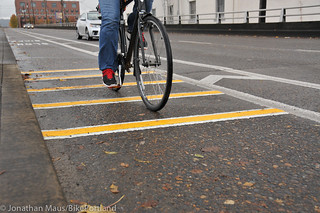

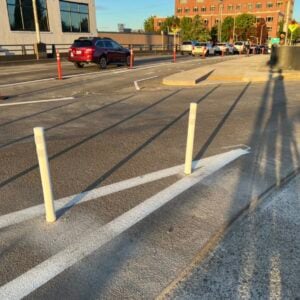
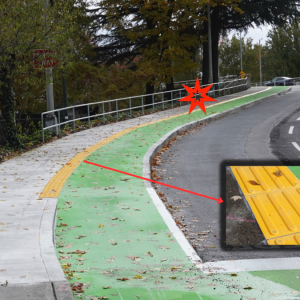
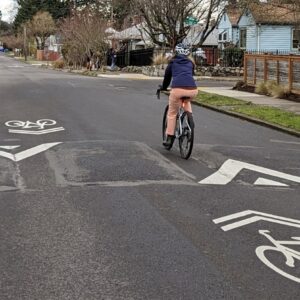
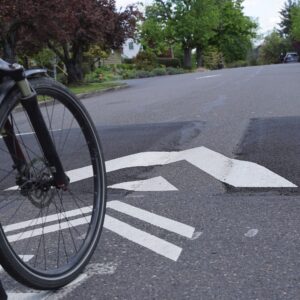
Thanks for reading.
BikePortland has served this community with independent community journalism since 2005. We rely on subscriptions from readers like you to survive. Your financial support is vital in keeping this valuable resource alive and well.
Please subscribe today to strengthen and expand our work.
I swerve around those bumps every time… they’re extremely jarring…
seems crazy that they need over a year to remove 5 strips of 1″x3′ plastic hazard from the roadway…
I could get out there with a crowbar and an 8 lb mallet and have those things smoothed out within a couple hours…
I know where you can get a long-handled scraping bar that would be perfect for the task…
Lowe’s hardware garden department….
Our tax dollars (soon to be street fee dollars) at work.
Why do it the simple, cheap, quick way when you can stretch this thing out for months or years?
Seriously?!!!!!?!?!?!? 2015?!?!?!?!
remember the snow storm? they had to put caution tape around the whole county building downtown since nobody could be bothered to shovel the few steps up to it.
I think the plan is to raise the rest of the bike lane up to the top of the plastic strips. “seems crazy” is kind of relative with this department.
…is calling this treatment a “speed bump” technically incorrect?
Should it not instead be called a “raised rumble strip” per the FHWA?
http://safety.fhwa.dot.gov/roadway_dept/pavement/rumble_strips/rumble_types/
Honestly, everyone complains about these strips, but the fact is that the cyclist pack going westward on the Hawthorne bridge goes at frightful speeds, with lots of pressure from the most macho riders for everyone else to be at top speed, not to mention a lot of unsafe swerving maneuvers and using the buffer strip as a passing lane on the approach.
I don’t like the rumble strips, but that’s not the point. The point is that it’s uncomfortable enough going over these that I have to slow down. That’s how speed bumps work, too. Nobody driving likes them, and their function is not to be liked.
When I don’t slow for the strips, it’s often because I’m even more worried about people behind me not slowing down and running into me. I believe it might be more effective if the strips, or another “jarring” means of slowing people down, should be installed over the whole width of the bridge to prevent people from swerving.
After all, you are entering an area shared with pedestrians with a dangerous downward curve and narrow path, and no matter how fast you think you are entitled to run through this area, you shouldn’t actually be going much more than 10mph anyway.
“Nobody driving likes them, and their function is not to be liked.”
gas tax anyone?
“the cyclist pack going westward on the Hawthorne bridge goes at frightful speeds, with lots of pressure from the most macho riders for everyone else to be at top speed”
please explain how my speed pressures other cyclists.
moreover, as a frightfully fast metrosexual i find your insinuation that i am macho to be mean.
“not to mention a lot of unsafe swerving maneuvers”
thanks for your concern but i’ve never had any complaints about my swerving.
“using the buffer strip as a passing lane”
i’m having trouble understanding how my passing another cyclist with 5+ feet of clearance could possibly be a reason for concern.
You’re missing the point. Regardless of your individual abilities, speed and injuries on the road are directly correlated, and predictable trajectories at safe speeds by other road users are key to avoiding collisions.
The transition from SE Madison at the bus stop is a major bike-ped conflict point. It’s complicated by curves, a bus stop, and a frequently wet concrete deck surface. It makes sense to ask people to slow down for 20 yards to reduce the risk of serious injury to all involved.
The county clearly hasn’t gotten the exact measure right, but the problem isn’t that the strips are jarring or unpleasant. Measures targeted at slowing bicycles in motion are not intended to be pleasant when you are the one riding the bicycle. They are intended to slow you down.
The actual problem is that the current rumble strips are not causing at least 90% of users to reduce their speed to no more than roughly 10 mph. And a large part of that is the swerve-around, which I’m going to venture and say is in fact unsafe in many cases, regardless of whether you receive personal complaints about it while on the bridge.
So I’m disappointed that the county’s only response to this is just to go ahead and remove the strips, rather than develop a better solution that will truly calm bicycle traffic.
And regarding pressure from macho cyclists on other cyclists, I can say from extensive personal experience that having another person going 1 mph faster than you directly behind you on a bicycle is a highly pressuring feeling. That’s why more timid riders avoid high-traffic bike-lane corridors and go for neighborhood greenways. But that option doesn’t exist on the bridge, so it’s up to everyone to be responsible, and you included.
please cite studies that correlate cycling speed an injury.
i’m seriously interested.
while conflict at this bus stop certainly occurs occasionally, 95% of the time this heavily travelled bike route is completely devoid of buses and pedestrians. when there are no pedestrians or buses presents i see no reason to moderate my speed to 10 mph. (a very slow speed that was rejected for the golden gate bridge mup.)
“predictable trajectories at safe speeds by other road users are key to avoiding collisions.”
thanks for you concern, daniel, but my trajectory is quite predictable at 25 mph. and after over a hundred thousand miles of cycling i have yet to collide with a cyclist — despite almost endoing a few times avoiding clueless newbies who were cycling as so called “safe speeds”.
“I can say from extensive personal experience that having another person going 1 mph faster than you directly behind you on a bicycle is a highly pressuring feeling”
seriously???
i have a responsibility to pass you safely but i have no desire or responsibility to moderate my speed merely to cater to your prejudices. if i pass you too closely, please call me out. otherwise stop worrying about other cyclists and just ride your own bike.
You’re right to call me out to cite actual evidence from studies. While the effect of vehicle speed on both cyclists and pedestrians is highly documented, the risks associated with bicycle speed is less well known. Here’s what I’ve found in a brief survey:
A series of studies associated with Frederick Rivara and Harborview in Seattle in the 90s and early 2000s, based on data gathered at emergency rooms in Seattle on thousands of urban bicycle-related injuries, does find (among other factors) a positive relationship between self-reported riding speeds > 15 mph and risk of severe injury.
http://www.smf.org/docs/articles/report#A10
http://injuryprevention.bmj.com/content/3/2/110.full.pdf
http://www.aafp.org/afp/2001/0515/p2007.html
However, there is also a study called the Taupo study that found that injuries from crashes where bicycles were riding less than 20 km/h were more severe than injuries from crashes where cyclists where riding more than 30 km/h. An interesting analysis of the overall question can be found here:
http://www.ors.wa.gov.au/Documents/Cyclists/ors-cyclists-1st-forum-haworth.aspx
As for your other points, again, it’s not about your personal self-assessed high abilities. Vehicle speed limits don’t exist to prevent race car drivers from crashing, they’re made for a population as a whole. And as the bicycle equivalent of such a highly skilled driver, it’s in fact your responsibility to watch out for the “clueless newbies” when you’re on a public road. Just as it’s their responsibility to learn quickly.
The Hawthorne Bridge presents a variety of challenging and narrow spaces where pedestrians, less-experienced and more-experienced cyclists interact, and I maintain that it makes sense to watch your speed and maintain high path predictability. Common behaviors on that stretch, including swerving, riding the tail, passing on the right, and passing in the buffer strip can and do put pressure to execute unsafe maneuvers putting themselves and often nearby pedestrians at risk.
I think the actual problem is that the bus stop is in a really poorly placed location.
that’s not how speed bumps work… with speed bumps you take no action at all when you’re doing the speed limit… speed bumps aren’t there to slow you down or make you uncomfortable; they’re there to keep you from speeding…
the speed limit is 35 mph where those strips are and I think it’s safe to say that it’s not safe to go over those strips at 35 mph… especially if you’re braking to slow down for the approach to the ramp onto the MUP…
rumple strips are to get your attention… but riders are already paying attention to a curve, ramp, and pedestrians at this point and don’t need a dangerous road design distracting them…
those strips are unsafe and unneeded…
they could make scores in the asphalt that would be safer and more effective…
13 months to remove these mistakes??? You’ve got to be kidding me. I mean, I know everyone’s busy, but it can’t be that hard a job to wait so freaking long!
It has been fun over the past months watching all the regular commuters get used to dodging those bumps. I’d say at least 50% of people skirt around them to the left at this point.
Bikes still go down that ramp to the narrowest part of the shared lane at ~12+ mph. Hardly “Slow”
sorry indy but 12 mph is slow. at the speed i can come to a stop in less than second.
it’s about my usual pace… not slow, not fast… I’d say over 20-25 mph here is fast, and under 10 is slow… it’s kind of downhill after all…
Now let’s see if they can actually remove them without ruining the pavement further in that spot by leaving a bunch of rough depressions from their grinding machine…
That’s pretty much guaranteed, at this point.
I continue to think that a “STOP HERE WHEN BUS IS PRESENT” sign and line that is at the top of the ramp is the best option. A conscientious cyclist thereby gains the authority to stop at that point which would block the less conscientious cyclists from disrupting the bus stop.
The problem IMO is the ambiguity. “Slow for pedestrians” leaves enough room that people just keep riding by, because, hey! someone else will stop, right?
On occasions where I have stopped here, I am usually passed on the right. On at least one occasion, my stopping for someone getting off the bus caused a woman behind me to fall off her bike, I suspect she only expected me to “slow.”
Why should I have to slow down/stop for the bus? If a bus rider isn’t smart enough to be aware of cyclists they’ll soon learn to be.
In my observation it seemed like 30-50% were steering around these fairy bumps in the first few weeks after they were put up, but now it seems to be more like 10-20%.
If they take the bumps out, the only real difference for me is I will no longer be rolling my eyes as “sensitive” people in front of me ride around them. Maybe I’ll start listening to Rob Kremer as a new way to make sure my eye muscles get enough exercise. 😉
On the other hand, if they’d fill in the potholes and smooth the pavement on Main St after I exit the bridge … well, that might actually smooth out my ride enough to notice.
Chamfering the leading edge with a disk grinder would leave the speed bumps intact and functional but eliminate the jarring strike when hit by narrow high pressure tires.
Frankly I don’t see much to complain about with them. It is great fodder for Bike Snob NY to comment on our delicate little fannys and eagerness to whine about small matters.
Just re-hashing the same consensus from the last time this came up, but the solution is not further gimping the bike facility, it’s moving the bus stop somewhere safe. Would we accept a bus stop in the middle of a motorized traffic lane that had only a couple of speed bumps to slow down traffic enough to make it “safe”?
busses stop in travel lanes all the time.
You may not be familiar with this chunk of road — the issue here is not the bus stopping, it’s that passengers debark into the travel lane, which is not a typical approach.
I am very familiar with this location. It is my commute. It definitely has conflicts, but between bus riders paying attention and cyclists paying attention (and being willing and able to yield) I have not seen or heard of collisions between riders and riders. It is actually no more complex than a roundabout with no signage. Everybody accepts responsibility and behaves in kind.
Try to imagine a retrofit that would eliminate the conflict yet still deposit bus riders near this location… An elevator through the bridge deck?
exactly the problem… and another fine example of how bicycles are 2nd class vehicles…
I hope they put the buss stop before the ramp when they redesign it…
god forbid cyclists ever have to slow down.
columbia river I5 crossing : car = hawthorne bridge : bike
Really it’ll be a moot point (as if it wasn’t already )in 2015, once the Tillikum opens the Hawthorn will only really effectively service (at best) about 10 East/West streets of Bike traffic.
Gutterbunny: Are you really claiming that 90 percent of the current Hawthorne Bridge riders will divert to the Tilikum Bridge?
Others have complained on this forum that the Tilikum Bridge isn’t useful because it’s out of direction.
My guess is that bike volumes on Hawthorne will drop by about 20 percent. The big change will be in the lower bus volumes on the Hawthorne Bridge as buses from the SE are rerouted to the Tilikum Bridge. Maybe that will reduce the bike/bus passenger boarding conflict.
I didn’t make any claim of percentages. But I suspect it will a significant number of riders diverted. Though I would be really surprised if it was lower than 40%, I suspect it to end up somewhere around 50%-60%, though it wouldn’t surprise me if it went higher. In my own observations most the Hawthorne bridge traffic heads south once it crosses to the east side.
Most the people that live south of Lincoln (once you get to Division it’s not even really a decision, and mind you many more ride the Clinton Street Greenways than Lincoln) will likely take the new bridge. For them even with the slight divergence on the west side isn’t as bad as the current divergence to the Hawthorn now.
And lets not forget that the Tillikum will have much better access to PSU/OHSU-Tram than the Hawthorne, which is perhaps even more significant than any other factor. Because that will draw people that work/study at those two institutions that live on the east side farther north than Hawthorne, perhaps as far north as Hollywood especially if the 50s bike highway gets built as well. It could make traveling that far north and east of the city comparable to auto times to those farther SW destinations.
Speed bumps or not the Hawthorn kind of sucks as a bike river crossing, it’s just better than the Ross Island or Morrison. But being better than the available alternatives doesn’t make it a good crossing, just better than the existing subpar crossings.
These little bumps are definitely a chapter in the next Bike Snob book.
There are speed control devices designed by traffic engineers for bicycles (and mopeds)…in the Netherlands they look like this:
https://www.flickr.com/photos/dylanpassmore/6805064750/in/photolist-bnm58j-bAfvyt-bAfzca-bnkJEA-3PpWkZ
Those look like fun.
Actually I believe those are designed to discourage scooters from using the bike facility…
that would be perfect, as long as they drained well…
I don’t think anywhere near 80-90% of Hawthorne Bridge traffic will redirect to the Tillikum, but I think it will be a lot more than 20%. I live to the south, so I’m actually exiting the bridge with other people headed south: at the Esplanade exit, the ramp to SE Grand/Clay/Division, and SE 7th. The vast majority of people splitting off at those three places are headed south of the UP tracks – down the Springwater, or up SE 9th and Milwaukie towards Brooklyn and points south – and I think it’s at least a third of the traffic from the Hawthorne. Add in the new MUP that will be running along the south side of the tracks from SE 8th/9th to 11th/12th, and that’s even more bridge bike commuters headed south, all of whom will find the Tillikum to be a favorable choice to the Hawthorne.
And that’s the NW-SE axis. There are also commuters between SW Portland (connecting in on the Barbur, riverfront and Terwilliger corridors) and either NE or inner SE Portland, who will also find the TIllikum works for them.
who cares? I welcome cyclists redirecting to the Tilicum and riding on the path instead of the Hawthorne, more room for the rest of us. Plus, you could have a flex schedule and commute at some other time than ‘rush hour’, during which the cyclists generally behave just as bad as the motorists in terms of being in a hurry.
And don’t forget all the Southernly head riders who come from/go through Ladd’s. I expect many of them will be taking the new bridge. I know I definitely will.
Speed is an issue. Experienced bike riders speeding past others are exactly like inpatient drivers on freeways and city streets. They think their needs out rule those of the other drivers/riders.
Just a simple phrase–slow the frack down. We all have the same rights to the road.
There’s a difference between experienced riders and fast riders. Not all fast riders are experienced.
You could even argue that going more than 12-15 mph on the MUP on the Hawthorne is kind of a rookie move considering all the potential, unpredictable traffic crammed into it.
Experienced isn’t how fast you can ride, it’s how well you can adapt to the circumstances of your ride.
except for their potential for carnage…
I mostly just ignore riders speeding past me…
Let’s demolish the viaduct and replace it with an at-grade intersection between Hawthorne and Water.
if we do, you’ll be stuck waiting for an oil-train unless you are sellwood -bound.
Not removed until 2015? Sounds like a pretty typical government project – they’ll have planners, a safety review, a recycling committee, environmental impact review, procurement of new crow bars at $2,000 each for the arduous task, a ribbon cutting ceremony to celebrate the government actually doing something useful for the first time in memory, government photographer, etc, etc, etc…………..
Reminds me of the Obamacare webite: If you can’t get the website to work you can send your application by mail. As Jay Leno says: Only the federal government could create a website that is slower than the US mail. http://www.youtube.com/watch?v=RILydIeyO8w
Perhaps a flashing sign to slow down?
Didn’t see this mentioned above (forgive me if I missed it), but I think the best option would be to move the cyclist ramp past the bus stop, so that the cyclists and bus riders don’t have to interact with one another. The buses would have to cross the bike travel lane, but I think that’s ultimately much less dangerous and complicated than the current setup.